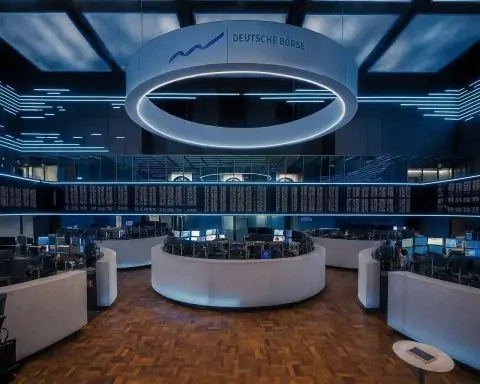Key Facts
- New All-Time High: Bitcoin’s price soared to a record high above $125,000 on Sunday, October 5, 2025, breaking its previous peak from mid-August (around $124,500) [1] [2]. The cryptocurrency jumped nearly 3% on the day and extended its winning streak to eight consecutive sessions, gaining about 11% in the first week of October alone [3] [4]. It pulled back slightly to the low-$123K range by Monday, October 6, after briefly topping out near $125,700 [5] [6].
- Safe-Haven Demand: A surge in safe-haven buying amid global economic jitters and a U.S. government shutdown underpinned the rally. Investors snapped up alternative assets like Bitcoin and gold, driving gold prices to within $75 of $4,000 (a record high) and Bitcoin to a lifetime high as confidence in fiat currencies wavered [7] [8]. The ongoing U.S. government shutdown (which began Oct. 1) has “galvanized haven demand” for Bitcoin, according to market analysts [9] [10]. Weaker U.S. dollar trends have added fuel – the dollar index is down over 12% in 2025, on track for its worst year since 1973, enhancing Bitcoin’s appeal as “digital gold” and an inflation hedge [11] [12].
- Institutional Inflows via ETFs:Massive institutional inflows into Bitcoin investment funds were a key catalyst. U.S.-listed spot Bitcoin ETFs saw about $3.24 billion of net inflows in the week ending Oct. 3, the second-largest weekly inflow on record, according to CoinDesk and fund data [13] [14]. Investors poured money into new Bitcoin exchange-traded funds – BlackRock’s Bitcoin ETF alone garnered ~$1.8 billion last week [15] – reflecting surging institutional demand. Analysts noted that these ETF purchases, largely by macro funds and asset managers, have been a primary driver of Bitcoin’s rally, rather than speculative leverage, marking a shift toward more stable long-term investment [16] [17].
- Macroeconomic Tailwinds: Broader macro factors set the stage for Bitcoin’s climb. U.S. equities rallied to new highs in late September, and expectations of looser monetary policy ahead (amid slowing growth and the Fed facing data blackout from the shutdown) bolstered risk assets [18] [19]. At the same time, the White House’s explicit pursuit of a weaker dollar and concerns about fiscal stability (exacerbated by political uncertainty in the U.S. and Japan) have fed what JPMorgan dubs the “debasement trade” – investors moving into hard assets like Bitcoin and gold to preserve value [20]. “What’s good for gold is also good for BTC,” noted analyst Noelle Acheson, pointing to rising inflation risks and the likelihood of renewed “money printing” that boosts global liquidity and flows into cryptocurrencies [21]. Similarly, Arca’s Chief Investment Officer Jeff Dorman observed that “the only time I buy BTC is when society loses faith in governments and local banks,” suggesting the backdrop of political strife and shutdown fears made Bitcoin a timely safe-haven bet [22].
- Altcoins and Broader Crypto Market: Bitcoin’s rally lifted the broader crypto market. Major altcoins logged gains in its slipstream: Ether (ETH) climbed to around $4,570 (its highest level in over a year) [23], XRP neared the $3.00 mark, and Solana (SOL) and Dogecoin (DOGE) each rose by a few percent during Asian trading hours on Sunday [24] [25]. By Monday, some altcoins saw even sharper moves – for instance, DOGE spiked double-digits intraday as whale buyers accumulated millions of tokens. Overall, the crypto market capitalization swelled as positive sentiment and fresh liquidity flowed into not just Bitcoin but also high-cap altcoins.
- Regulatory & Institutional Developments: The rally coincides with a markedly more crypto-friendly regulatory climate in the U.S. and rising mainstream acceptance. President Donald Trump’s administration has embraced pro-crypto policies – Trump even signed a “Crypto Bill” into law in July 2025 to modernize the U.S. financial system, establishing clear legal frameworks for digital assets [26] [27]. Binance CEO Changpeng “CZ” Zhao lauded Trump as the “Crypto President” for advocating cryptocurrency innovation, a stance that has likely encouraged institutions to participate in the market [28] [29]. Traditional finance is increasingly on board: for example, Morgan Stanley’s wealth management arm now recommends allocating 2%–4% of client portfolios to crypto, citing Bitcoin’s strong performance and dwindling exchange supplies (a sign of long-term investor holding) [30]. In total, Bitcoin ETFs now hold over 1.5 million BTC (~7.2% of the total supply) on behalf of investors [31] [32] – a remarkable institutional stake in the asset. “Bitcoin’s new high is a signal of the asset’s growing maturity,” said Matt Poblocki of Binance Australia, pointing to global regulatory progress and the influx of institutional money as validation of Bitcoin’s legitimacy [33].
- Experts See Further Upside: Market watchers are debating how high Bitcoin could go next. In the near term, analysts at Standard Chartered project Bitcoin will continue rising throughout the U.S. government shutdown, potentially reaching $135,000 in the coming weeks [34]. They note that Bitcoin’s price has become correlated with U.S. fiscal risks and the bond market’s “term premium,” acting as a hedge when government stability is in question [35]. Crypto-focused strategists are even more bullish: pseudonymous trader “CrediBULL Crypto” asserts that a new leg toward $150,000 has likely begun now that the previous peak was cleared, with any pullbacks seen as “buy the dip” opportunities [36]. Other veteran traders highlighted the extraordinary momentum – Bitcoin rocketed from ~$110K to ~$125K in just one week [37] – as evidence of a robust uptrend. Historical patterns also favor the bulls: October (sometimes nicknamed “Uptober”) is seasonally a strong month for Bitcoin, which has notched gains in 9 of the past 10 Octobers [38] [39]. “It’s still woefully under-allocated in portfolios,” reminded Acheson, who along with others suggests that supportive macro conditions (lower interest rates, higher liquidity) could sustain crypto’s rise into year-end [40].
Bitcoin Hits a Record High Above $125,000
Bitcoin’s price blasted through its all-time high, trading as high as $125,653 on Sunday, October 5, 2025 [41]. This new peak marks a significant milestone for the world’s largest cryptocurrency. The previous record (~$124,500) was set in mid-August, when markets rallied on hopes of friendlier U.S. crypto regulations and strong institutional buying [42]. This time, Bitcoin broke the record in the midst of “Uptober” – a nickname traders use for October’s often bullish price action – and it lived up to the name. By early Sunday in New York, Bitcoin climbed as high as $125,689, according to Bloomberg, before settling back around the mid-$123K level later in the day [43]. The weekend surge capped an impressive run: Bitcoin rose for eight straight days through Friday, October 3, and was up roughly 11% for the week and over 33% year-to-date in 2025 [44].
This rally appeared to be part of a broader “risk-on” wave sweeping markets. Not only did Bitcoin hit new highs, but U.S. stock indexes also rallied into record territory at the start of October, and Japan’s Nikkei stock average soared over 5% to an all-time high on Oct. 6 after a surprise dovish turn in Japanese politics [45]. Meanwhile, traditional safe havens like gold were also bid to record levels. Gold futures nearly breached $4,000/oz – a fresh peak – around the same time Bitcoin crossed $125K [46]. Seeing gold and Bitcoin jump in tandem is unusual, and it underscored a flight from fiat currency assets. “Politics [are] firmly back in the driver’s seat of global markets,” wrote Reuters analyst Kevin Buckland, noting that Bitcoin vaulting past $125K on Sunday came just as gold and Japanese equities rallied in response to political developments [47] [48].
By Monday October 6, Bitcoin’s price had consolidated just below the record high, trading around $123,600 in the morning hours [49]. Traders will be watching to see if this pause is a sign of resistance at the $125K level or merely a brief calm before further gains. Thus far, buyer demand has remained robust; each slight dip has seen buyers step in, reflecting a strong bullish sentiment as the market digests Bitcoin’s new price territory.
Safe-Haven Demand Amid Shutdown and Economic Jitters
One of the most cited drivers behind Bitcoin’s October surge is its growing role as a safe-haven asset in times of uncertainty. Over the October 5–6 timeframe, the United States federal government was in a state of partial shutdown, a political standoff that began on October 1 and showed no immediate signs of resolution [50]. This paralysis in Washington has “frayed nerves” for investors and cast doubt on economic data releases (like jobs reports) that were delayed [51]. In response, many traders rotated into assets that can serve as a store of value outside the traditional financial system, notably gold and Bitcoin [52]. As Reuters observed, Bitcoin and gold jumped as traders snapped up alternative assets amid the U.S. government shutdown [53]. Bitcoin, often dubbed “digital gold,” seemed to fulfill that thesis: demand spiked as confidence in government solvency and fiat money stability wavered.
Several market commentators pointed out that the backdrop of political and fiscal uncertainty makes Bitcoin especially attractive. “The shutdown matters this time around,” said Geoffrey Kendrick, head of digital assets research at Standard Chartered Bank [54]. Unlike prior short government funding lapses, this shutdown arrived when macro conditions were already tenuous – inflation is still above target and U.S. debt levels are high. “This year, Bitcoin has traded with ‘U.S. government risks,’ as best shown by its relationship to the U.S. Treasury term premium,” Kendrick explained, referring to how Bitcoin’s price has been rising in step with measures of long-term U.S. government credit risk [55]. In other words, the more investors worry about U.S. fiscal troubles, the more appealing Bitcoin becomes as a hedge. Kendrick predicted that “Bitcoin will rise throughout the shutdown” and even ventured that it “will soon reach $135,000,” given the current trajectory [56].
Beyond the shutdown, wider macroeconomic forces are bolstering Bitcoin. The U.S. Dollar – the world’s reserve currency – has been on the back foot, declining for weeks. On Friday (Oct. 3), the dollar index posted multi-week losses against other major currencies [57]. The White House’s policy stance may be contributing: President Trump’s administration has openly aimed for a weaker dollar to boost U.S. exports and reduce trade deficits [58]. “Faith in the value of fiat currencies – already battered by the White House’s open and active pursuit of a weaker dollar – takes another blow,” Reuters noted in a market briefing, referring to how political moves in both the U.S. and Japan undermined confidence in paper money [59]. This eroding trust in fiat currency fed into what JPMorgan analysts call the “debasement trade,” meaning investors seek refuge in assets that can’t be debased by government spending or central bank money-printing [60]. Bitcoin, with its fixed supply, fits that narrative, much like gold. Noelle Acheson, author of the Crypto Is Macro Now newsletter, captured this sentiment: “US inflation is more likely to increase than decrease… and what’s good for gold is also good for BTC, especially since it is still woefully under-allocated,” she explained [61]. Acheson added that with the prospect of central banks easing – through “lower rates, yield curve control and lots and lots of ‘money printing’” – global liquidity is likely to rise, “which will seep into the riskier corners of institutional portfolios” such as crypto [62].
This year has also seen geopolitical tensions and conflict risks on the rise (from Eastern Europe to the Middle East), which some analysts cite as another reason investors are hedging with Bitcoin. While not directly tied to the Oct 5–6 spike, the general climate of uncertainty in 2025 has reinforced Bitcoin’s appeal as an asset not controlled by any single government or central bank. As Arca’s CIO Jeff Dorman put it bluntly: “The only time I buy BTC is when society loses faith in governments and local banks.” Ahead of the shutdown, Dorman argued “$BTC [is] likely a good buy here” given the situation [63]. That viewpoint – that Bitcoin thrives when confidence in traditional systems erodes – appears to have been validated over the past week’s price action.
Notably, gold’s simultaneous record-breaking run underscores that Bitcoin’s rally was part of a larger flight to safety. Gold reached an all-time high just shy of $4,000/oz around Oct 5–6 [64], and both gold and Bitcoin have been climbing in tandem since late September. Historically, Bitcoin has sometimes traded more like a risk asset (rising with stocks), but the current environment shows it trading more like a safe-haven asset (rising with gold) in response to government and currency fears. This dynamic might continue if the U.S. shutdown drags on or if other macro risks (like central bank policy changes or geopolitical events) unsettle investors. In short, Bitcoin is benefiting from a “perfect storm” of macro catalysts: political gridlock, fiat debasement fears, and investors’ growing desire for inflation-resistant stores of value.
ETF Inflows and Institutional Money Fuel the Rally
Perhaps the most pivotal development underpinning Bitcoin’s record highs is the wave of institutional investment flowing in through Bitcoin Exchange-Traded Funds (ETFs). In the first week of October, cryptocurrency funds saw extraordinary inflows, signaling that big-money investors are increasingly eager to gain exposure to Bitcoin. According to CoinDesk data, U.S.-listed spot Bitcoin ETFs registered a net inflow of $3.24 billion in the week ending Oct. 3 – a massive uptick in demand [65]. It was the second-largest weekly inflow ever recorded for Bitcoin ETFs (surpassed only by a week in late 2024) [66]. This flood of capital into Bitcoin funds was a key catalyst cited for the price surge.
To put those numbers in perspective, that one week of inflows into Bitcoin ETFs equated to roughly 1,430 BTC being purchased per day by these funds (using the average price), a rate of buying that nearly matches the rate of new Bitcoin creation by miners [67] [68]. In other words, institutional demand via ETFs is soaking up new supply almost as fast as it’s mined, creating a supply-demand imbalance that drives prices higher. Vincent Liu, CIO at trading firm Kronos Research, noted that Bitcoin’s price jump was clearly “attributed to ETF inflows,” while also citing “tight exchange supply, a weaker dollar, and macro uncertainty” as additional factors [69].
Leading the charge was the world’s largest asset manager, BlackRock. BlackRock’s IBIT spot Bitcoin ETF saw about $1.8 billion of those inflows, bringing its total assets under management to a whopping ~$96 billion [70]. Fidelity’s Bitcoin fund (the second-largest) took in roughly $692 million the same week [71]. With contributions from other issuers as well, Bitcoin ETFs collectively drove much of the buying. “Bitcoin ETFs drove BTC to a new all-time high above $125,000 with $3.24B in weekly inflows,” one analysis summarized [72]. This indicates that institutional investors – from hedge funds to family offices – are allocating fresh capital to Bitcoin through these regulated investment vehicles.
It’s noteworthy that these spot Bitcoin ETFs only launched relatively recently (the first U.S. spot Bitcoin ETFs began trading in January 2024 after regulatory approvals). The fact that they are now seeing record interest suggests a sea change in acceptance of crypto on Wall Street. Bitcoin ETFs now collectively hold over 1.5 million BTC (valued around $188 billion at current prices), which accounts for roughly 7.2% of Bitcoin’s total circulating supply being held in funds for investors [73] [74]. That is a tremendous share, illustrating how much Bitcoin has been “financialized” for mainstream investors. “Institutional buyers are acquiring Bitcoin faster than miners can produce it,” noted the CoinCentral report, highlighting that businesses and funds together have been accumulating thousands of BTC per day in 2025, far outpacing new supply [75] [76]. This dynamic creates a supply squeeze that naturally elevates price as demand grows.
Market analysts emphasized that this rally has a different character than past speculative spikes. Will Clemente, a well-known crypto analyst, pointed out that the current move was not driven by high-leverage traders or one-off corporate treasury buys, but by steady spot buying via ETFs – “likely macro portfolio managers and funds viewing BTC as a rotation from commodities & small caps,” he explained [77]. In other words, traditional investors are rebalancing portfolios to include Bitcoin, treating it as an alternative asset class akin to a commodity or tech stock. This more strategic buying can be stickier and less volatile than retail-fueled frenzies, potentially lending the rally more durability.
The surge of institutional interest can be partly attributed to improving regulatory clarity. In the U.S., the shift in administration at the start of 2025 led to a markedly more positive stance on crypto. President Trump’s government has been openly pro-crypto: Trump himself has advocated using cryptocurrency to modernize the aging financial infrastructure, and in July he signed a bipartisan Crypto Bill into law that outlines a legal framework for integrating digital assets into the U.S. financial system [78] [79]. These developments have given institutions confidence that Bitcoin and other cryptocurrencies will be allowed to thrive under U.S. law. Binance CEO CZ went so far as to call Donald Trump the “Crypto President”, reflecting the industry’s approval of his support [80]. Beyond the U.S., other countries are also embracing crypto innovation – for example, Japan’s new ruling party leader Sanae Takaichi (elected on Oct. 4) is known for her openness to blockchain and even the possibility of lowering crypto tax rates [81]. Global regulatory progress – including Europe’s comprehensive MiCA regulations and multiple countries approving Bitcoin ETFs – has reduced some of the uncertainty that previously kept institutional money sidelined. Matt Poblocki of Binance’s Australian unit commented that Bitcoin’s record high “signals the asset’s growing maturity,” attributing it to “global regulatory progress and institutional inflows through U.S. spot Bitcoin ETFs” as a sign that crypto is coming of age [82].
Even traditional banks are now encouraging exposure to crypto. In a report to clients (circulated around Oct. 6), Morgan Stanley advised that investors with growth-oriented portfolios consider a 2%–4% allocation to cryptocurrencies (mainly Bitcoin and Ethereum) [83]. The Wall Street giant suggested that such an allocation could enhance returns without undue risk, especially as crypto now trades with greater liquidity and institutional involvement. (For conservative portfolios focused on wealth preservation, Morgan Stanley still suggested 0% crypto, underscoring that it’s not without risk [84].) Still, this recommendation from a major bank would have been unthinkable a few years ago – a clear sign of how far Bitcoin has come in earning legitimacy. Additionally, on-chain data showed that Bitcoin balances on exchanges hit six-year lows during this period [85], meaning long-term investors are pulling coins off trading platforms (often to hold in cold storage). This typically signals strong conviction in future price gains, as investors aren’t looking to sell imminently. It also contributes to the supply shortage in the market.
All of these factors – rising ETF adoption, regulatory green lights, and institutional endorsements – created a favorable feedback loop for Bitcoin. The more that reputable institutions buy in, the more comfortable other investors become in following suit, and the more upward pressure on price as supply tightens. The first week of October 2025 may be remembered as a tipping point where institutional FOMO (fear of missing out) on Bitcoin truly kicked into high gear.
Altcoins Follow Bitcoin’s Lead (Ethereum, XRP See Upticks)
Whenever Bitcoin makes a major move, the rest of the cryptocurrency market tends to react. Over October 5–6, as Bitcoin punched through its record high, many altcoins (alternative cryptocurrencies) also notched notable gains. While the spotlight was on Bitcoin, these other digital assets benefited from the positive sentiment and inflows into the crypto space.
Second-largest crypto Ethereum (ETH) climbed alongside Bitcoin, reaching about $4,570 per coin during the rally [86]. This brought ETH close to its own all-time highs (around $4,800 back in late 2021). Investors often view Ethereum as having a somewhat different value proposition than Bitcoin – it’s the backbone of decentralized finance and hosts many blockchain projects – but in bullish periods the two often rise together. Ethereum’s rise was also helped by fresh fund inflows: spot Ethereum ETFs saw roughly $1.3 billion in net investments last week, reversing what had been the worst week of outflows for ETH funds just prior [87] [88]. In fact, one of BlackRock’s new funds (the ETHA ETF) alone took in about $692 million [89], indicating substantial institutional interest in Ethereum as well. The increased demand pushed Ethereum’s price higher, and it held above the $4.5K level through the weekend.
Other major altcoins saw a price pop too. Ripple’s XRP, for instance, nearly hit $3.00 – a level it hasn’t seen in several years – amid the general market euphoria [90]. XRP has had its own bullish catalysts (including a high-profile legal victory over the SEC earlier in 2025), and the broad uptick in crypto values gave it an extra push toward reclaiming its historic highs. Solana (SOL), a leading smart contract platform often dubbed an “Ethereum competitor,” traded up to around $234, continuing a strong multi-week uptrend [91]. Even meme-inspired Dogecoin (DOGE) enjoyed a revival, spiking about 5% on Sunday to roughly $0.26 [92] – and then jumping further on Monday amid reports that large holders (“whales”) accumulated over 30 million DOGE during the dip, betting on future gains. Dogecoin’s renewed momentum – while still far below its all-time high of ~$0.73 – exemplifies how speculative fervor returns to smaller coins when Bitcoin rallies and draws new money into crypto.
Market-wide, the crypto market capitalization climbed as well, adding tens of billions of dollars over the two-day span. Importantly, trading volumes on exchanges were up significantly from the prior week, indicating broad participation in the rally. Many altcoins, especially those in the top 20 by market size, moved in correlation with Bitcoin’s surge, typically gaining a more modest few percent. This kind of synchronous movement is common in crypto: Bitcoin’s dominance (its share of total crypto market value) often grows during initial stages of a rally, but then altcoins play “catch-up” as investors rotate into higher-beta opportunities. By Monday, some traders were already speculating that an “altcoin season” might emerge if Bitcoin’s price stabilizes at a new plateau. Historically, when Bitcoin establishes a new high and consolidates, some smaller-cap assets see outsized jumps as traders search for relative value.
One should note, however, that Bitcoin still led the pack by far in terms of year-to-date performance and investor focus in early October. The narrative driving this rally – institutional adoption, macro hedge – is very Bitcoin-centric (given its unique position as digital gold). Altcoins rode Bitcoin’s coattails rather than any big shifts in their own fundamentals during this short window. Nonetheless, the broad-based uptick across crypto was a welcome development for investors who hold diversified crypto portfolios. It showed that confidence in the asset class as a whole is rising, not just in Bitcoin alone.
Quotes and Commentary from Experts
The rapid rise of Bitcoin past $125K drew a range of reactions from financial analysts, crypto experts, and market commentators. Here are some of the notable insights and quotes from experts during the Oct 5–6 period:
- Geoffrey Kendrick, Standard Chartered (Major Bank): Kendrick highlighted the impact of U.S. political dysfunction on Bitcoin’s price. “The shutdown matters this time around,” he emphasized, noting that Bitcoin has been trading in line with U.S. government risk indicators [93]. He predicted Bitcoin could climb to ~$135,000 in short order if the government shutdown persists, effectively making BTC a barometer of U.S. fiscal confidence [94].
- Jeff Dorman, Arca (Crypto Investment Firm): Dorman pointed to a crisis-of-confidence dynamic. He said he only buys Bitcoin “when society loses faith in governments and local banks,” and suggested the U.S. budget standoff made Bitcoin an attractive buy heading into October [95]. This quote encapsulates the view of Bitcoin as “fear asset” for those worried about the traditional system.
- Noelle Acheson, Macro Analyst: Acheson provided a macroeconomic take, arguing that inflation and liquidity trends favor Bitcoin. She noted that with global risks escalating and likely responses of renewed easing, “what’s good for gold is also good for BTC.” She pointed out that increased government borrowing and potential currency debasement will drive more investors to seek refuge in Bitcoin just as they do with gold [96]. Her commentary ties Bitcoin’s fortunes to broader macro and monetary policy cycles.
- Will Clemente, Crypto Analyst (Reflexivity Research): Clemente focused on the character of the current rally. He observed that the buying was coming from spot (non-leveraged) demand via ETFs rather than the typical speculative frenzy [97]. “The most bullish thing about this move… it wasn’t driven by treasury companies or perp degens, it was driven by spot ETF buying,” he wrote, indicating that institutional money (like “macro PMs and funds”) rotated into BTC as a strategic play [98]. Clemente took this as a very positive sign of sustainable support behind Bitcoin’s price.
- Jeff Mei, COO of BTSE (Crypto Exchange): Mei commented on shifting investor behavior amid the U.S. government shutdown. He said many are viewing Bitcoin as a safe haven and “diversifying away from U.S. dollars and Treasury bonds” during this period of monetary uncertainty [99]. With the dollar weakening and bond yields volatile, Mei explained it “makes sense for investors to move capital into other currencies and Bitcoin,” aligning with the broader trend of BTC being seen as digital hard currency [100].
- Vincent Liu, Kronos Research: Liu echoed others in attributing the price strength to fundamental flows. He cited “ETF inflows, a weaker dollar, and macro uncertainty” as the trifecta fueling Bitcoin’s rise [101]. Importantly, he also mentioned “tight exchange supply” – reflecting that a lot of Bitcoin is being locked up by long-term holders and institutional custodians, leaving less available to trade, which can exaggerate price moves up.
- Charles Edwards, Capriole Investments: Edwards, a prominent crypto fund manager, had earlier predicted that once Bitcoin broke above $120,000, it could “quickly move” toward $150,000 [102]. His rationale was that clearing major resistance levels triggers a new wave of technical and FOMO-driven buying. Indeed, the move from $110K to $125K in just a week (late September to early October) underscored how swiftly Bitcoin can appreciate in a “price discovery” phase with little historical overhead resistance [103].
- Michaël van de Poppe, Trader & Analyst: Van de Poppe, known for his trading insights, remarked on Bitcoin’s explosive October start. He pointed out the strength of moving $15,000 higher in one week (from $110K to $125K) [104], implying that momentum and market structure were strongly bullish. He, like others, sees dips as likely shallow. “Just like last time, anything above the lows of the origin [of the move]” is still on track, he said, suggesting Bitcoin could pull back a bit but as long as it stays well above prior support (e.g. six-figure territory), the uptrend is intact [105].
- Fabian Dori, Sygnum Bank (Swiss Digital Bank): Dori provided an on-chain perspective. As Sygnum’s CIO, he noted that data shows the recent rally correlating with an accumulation phase – long-term holders are not selling heavily into this strength, and short-term speculators have mostly stabilized [106]. This implies selling pressure is relatively low, which can prolong a rally. If “selling pressure from long-term holders appears to be easing,” as Dori observed, it means the investors who bought at lower prices are content to keep holding, anticipating even higher valuations [107]. Such behavior often precedes extended bull markets.
Together, these insights paint a picture of a market where fundamental conviction is high. Unlike some past episodes driven mainly by retail hype, the commentary from experts in October 2025 centers on macro strategy, institutional flows, and long-term positioning. There is a common thread: Bitcoin is increasingly seen as a legitimate asset to hedge against economic uncertainties and to participate in by major financial players. The tone from analysts is notably optimistic, albeit with the usual caution that volatility is inherent.
What’s Next: Outlook and Key Factors to Watch
After a milestone like $125,000, many investors are wondering what comes next for Bitcoin. The consensus among several high-profile analysts is that the outlook remains bullish, though not without potential short-term twists.
A key near-term factor is the duration of the U.S. government shutdown. As Standard Chartered’s team noted, the longer Washington remains at an impasse, potentially “for weeks”, the more Bitcoin may attract safe-haven flows [108] [109]. Ironically, negative news for the traditional system (e.g. unpaid federal workers, delayed economic reports, and political brinksmanship) could continue to be positive for Bitcoin’s price. Traders will be monitoring any developments in Congress closely. If a resolution to fund the government comes swiftly or unexpectedly, there could be a temporary pullback in assets like gold and Bitcoin that benefited from the turmoil. Conversely, an extended fiscal showdown – or new turmoil around raising the debt ceiling later on – might reinforce the narrative of Bitcoin as a hedge against government dysfunction.
Monetary policy and interest rates also loom large. The U.S. Federal Reserve had been signaling a potential pivot to cutting rates in 2025 if inflation continued to ease. However, with the shutdown “flying blind” the Fed by depriving it of data [110], there’s uncertainty about the timing of any policy moves. If the Fed holds rates steady or even starts easing sooner to support the economy (especially if government spending is constrained during the shutdown), that could lower bond yields and the dollar further – a scenario in which Bitcoin traditionally shines because lower yields make non-yielding assets like gold and BTC more attractive. On the other hand, any hawkish surprise or resurgence of inflation that forces tighter policy might test Bitcoin’s resilience later in the year. For now, though, markets seem to expect that the next big Fed move is a cut, and that anticipation is part of what’s lifting all risk assets, Bitcoin included [111].
Another aspect to watch is institutional momentum. The recent burst of ETF inflows suggests institutions are in accumulation mode. If this continues – for instance, if more funds allocate to Bitcoin as year-end approaches – it provides a steady bid underpinning the market. There are also rumors that additional Bitcoin ETF products could launch or that large pensions and endowments might be dipping their toes into crypto. Any confirmation of such moves could further bolster sentiment. As of early October, Bitcoin’s market capitalization (~$2.4 trillion at $125K price) still pales in comparison to, say, gold’s market cap or global stock markets, so many bulls argue there is room for significant upside if even a small percentage of global assets reallocate to BTC.
Many analysts have set their sights on the next big psychological milestone: $150,000. This level is not only a nice round number but also roughly where some technical price projections land if the current trend channel holds. Crypto trader CrediBULL Crypto voiced a common belief that now that Bitcoin is in “price discovery” above its old high, the path of least resistance is upward. “We blast through [the old highs]… the next leg to 150K+ has begun, in my opinion,” he wrote [112]. That said, markets rarely move in a straight line. We may see periodic corrections or consolidation phases – even a pullback of 10–20% would not be unusual after such a rapid ascent. But as long as Bitcoin stays above key support levels (for example, many point to the previous breakout zone around $110K–$120K as a support band), bullish analysts aren’t overly concerned [113]. Any dips into that range could even invite strong buying interest (so-called “buying the dip”), as evidenced by long-term holders who have been patiently accumulating.
It’s also worth considering the broader crypto ecosystem outlook. If Bitcoin continues to hold firm or climb, attention may shift to whether altcoins will rally more strongly (a classic later-stage bull market behavior). Already, we saw Ethereum and others perking up, and there are fundamental events on the horizon – for instance, Ethereum’s network upgrades or other layer-1 blockchains launching improvements – that could act as catalysts. Additionally, regulatory news will remain significant. The next U.S. presidential election is in 2028, but in the near term, any moves such as the U.S. Securities and Exchange Commission (SEC) approving more crypto products, or other countries like Canada, Brazil, etc., expanding crypto ETF offerings, will be closely watched. On October 5, for example, news broke that REX and Osprey filed 21 new cryptocurrency ETF applications [114], indicating issuers are racing to list more products – a sign that the financial industry expects sustained investor interest in crypto.
From a historical viewpoint, we are in what many consider the post-halving bull cycle (Bitcoin underwent its quadrennial “halving” event in 2024, which historically precedes multi-year price peaks). In past cycles (2013, 2017, 2021), Bitcoin’s price tended to accelerate significantly about 12–18 months after the halving. If that pattern holds, late 2025 could indeed see peak bullishness. Some optimistic forecasters even speculate on targets beyond $150K – with figures like $200K or higher cited by long-term stock-to-flow models and such – but those remain outlier predictions. More concretely, large institutions like Standard Chartered have publicly posited ~$100K+ targets in the past and are now revising them upward given current momentum [115]. JPMorgan’s mention of the “debasement trade” suggests they acknowledge Bitcoin’s role in portfolios as a hedge, though that bank hasn’t issued a near-term price target. Bloomberg’s crypto outlook reportedly sees a constructive trend as well, tying Bitcoin’s gains to the concept of “Uptober” – historically, Bitcoin has ended October higher than it started in 9 of the last 10 years [116]. If that seasonal strength holds, we could envision Bitcoin heading into November at even loftier levels.
Lastly, it’s important to remain mindful of volatility and risks. Crypto markets can be sensitive to sudden shifts in sentiment. Any adverse regulatory action (for example, if a country unexpectedly banned crypto trading or if a major exchange faced issues) could temporarily jolt prices. Likewise, if the macro environment flips – say, a surprising spike in inflation leading to aggressive Fed tightening – it could test the “Bitcoin as safe haven” thesis if investors retreat to cash. For now, though, the balance of factors seems tilted in Bitcoin’s favor: monetary policy is easing, not tightening; institutional money is entering, not leaving; and political/regulatory winds have turned friendlier. As a result, many traders and analysts are entering the fourth quarter of 2025 with optimism that Bitcoin’s best days may still lie ahead in this cycle.
In summary, the period of October 5–6, 2025 witnessed Bitcoin achieving a historic price milestone, driven by a confluence of supportive elements – from haven-seeking in a shaky macro climate to unprecedented institutional adoption through ETFs. The developments of these two days highlight how far Bitcoin has come in the financial mainstream and suggest that the asset is increasingly influenced by global economic currents and big-player capital flows. While short-term market fluctuations are inevitable, the overarching narrative emerging is one of growing legitimacy and demand for Bitcoin as a staple in the modern financial landscape. As one analyst quipped on social media, “It took 14 years for Bitcoin to get to $125K – the next 14 months could be even more interesting.” The world will be watching to see if Bitcoin can maintain this momentum and perhaps turn the once-unfathomable (six figures) into the new normal, or even set its sights on the next big figure on the horizon.
Sources:
- Reuters – “Bitcoin hits all-time high above $125,000” (Oct 5, 2025) [117] [118]
- Reuters – “Political waves send Nikkei, bitcoin, gold soaring to record highs” (Global Markets report, Oct 6, 2025) [119] [120]
- Reuters – “Morning News: Politics dominate markets, from Japan stocks to bitcoin” (Oct 6, 2025) [121] [122]
- CoinDesk – “Bitcoin Surges to Record High Above $125K After $3.2B in Spot BTC Inflows” (Oct 5, 2025) [123] [124]
- Bloomberg – “Bitcoin Crosses Fresh Record as ‘Uptober’ Narrative Takes Hold” (Oct 5, 2025) [125]
- CoinCentral – “Bitcoin Price: BTC Breaks $125,000 All-Time High as Record ETF Inflows Surge” (Analysis, Oct 6, 2025) [126] [127]
- CoinCentral – “Bitcoin ETF Inflows Hit 10-Month High as Institutional Money Floods In” (Oct 6, 2025) [128] [129]
- CoinCentral – “CZ Calls Trump the ‘Crypto President’ as Bitcoin Hits New High” (Oct 5, 2025) [130] [131]
- CoinCentral – “Morgan Stanley Advises 2% to 4% Crypto Allocation for Client Portfolios” (Oct 6, 2025) [132]
- CoinDesk – Quotes from Jeff Dorman and Noelle Acheson (via X/Twitter, Oct 2025) [133] [134]
- CoinDesk – Market data on altcoin moves (Oct 5, 2025) [135] [136]
References
1. www.reuters.com, 2. www.reuters.com, 3. www.reuters.com, 4. coincentral.com, 5. www.reuters.com, 6. www.reuters.com, 7. www.reuters.com, 8. www.reuters.com, 9. www.coindesk.com, 10. www.reuters.com, 11. www.coindesk.com, 12. coincentral.com, 13. www.coindesk.com, 14. coincentral.com, 15. coincentral.com, 16. coincentral.com, 17. coincentral.com, 18. www.reuters.com, 19. www.reuters.com, 20. www.reuters.com, 21. www.coindesk.com, 22. www.coindesk.com, 23. www.coindesk.com, 24. www.coindesk.com, 25. www.coindesk.com, 26. coincentral.com, 27. coincentral.com, 28. coincentral.com, 29. coincentral.com, 30. coincentral.com, 31. coincentral.com, 32. coincentral.com, 33. coincentral.com, 34. www.reuters.com, 35. www.reuters.com, 36. coincentral.com, 37. coincentral.com, 38. www.bloomberg.com, 39. coincentral.com, 40. www.coindesk.com, 41. www.reuters.com, 42. www.reuters.com, 43. www.bloomberg.com, 44. www.reuters.com, 45. www.reuters.com, 46. www.reuters.com, 47. www.reuters.com, 48. www.reuters.com, 49. www.reuters.com, 50. www.reuters.com, 51. www.reuters.com, 52. www.reuters.com, 53. www.reuters.com, 54. www.reuters.com, 55. www.reuters.com, 56. www.reuters.com, 57. www.reuters.com, 58. www.reuters.com, 59. www.reuters.com, 60. www.reuters.com, 61. www.coindesk.com, 62. www.coindesk.com, 63. www.coindesk.com, 64. www.reuters.com, 65. www.coindesk.com, 66. coincentral.com, 67. coincentral.com, 68. coincentral.com, 69. coincentral.com, 70. coincentral.com, 71. coincentral.com, 72. coincentral.com, 73. coincentral.com, 74. coincentral.com, 75. coincentral.com, 76. coincentral.com, 77. coincentral.com, 78. coincentral.com, 79. coincentral.com, 80. coincentral.com, 81. www.reuters.com, 82. coincentral.com, 83. coincentral.com, 84. coincentral.com, 85. coincentral.com, 86. www.coindesk.com, 87. coincentral.com, 88. coincentral.com, 89. coincentral.com, 90. www.coindesk.com, 91. www.coindesk.com, 92. www.coindesk.com, 93. www.reuters.com, 94. www.reuters.com, 95. www.coindesk.com, 96. www.coindesk.com, 97. coincentral.com, 98. coincentral.com, 99. coincentral.com, 100. coincentral.com, 101. coincentral.com, 102. coincentral.com, 103. coincentral.com, 104. coincentral.com, 105. coincentral.com, 106. coincentral.com, 107. coincentral.com, 108. www.reuters.com, 109. www.reuters.com, 110. coincentral.com, 111. www.coindesk.com, 112. coincentral.com, 113. coincentral.com, 114. coincentral.com, 115. www.reuters.com, 116. www.bloomberg.com, 117. www.reuters.com, 118. www.reuters.com, 119. www.reuters.com, 120. www.reuters.com, 121. www.reuters.com, 122. www.reuters.com, 123. www.coindesk.com, 124. www.coindesk.com, 125. www.bloomberg.com, 126. coincentral.com, 127. coincentral.com, 128. coincentral.com, 129. coincentral.com, 130. coincentral.com, 131. coincentral.com, 132. coincentral.com, 133. www.coindesk.com, 134. www.coindesk.com, 135. www.coindesk.com, 136. www.coindesk.com










